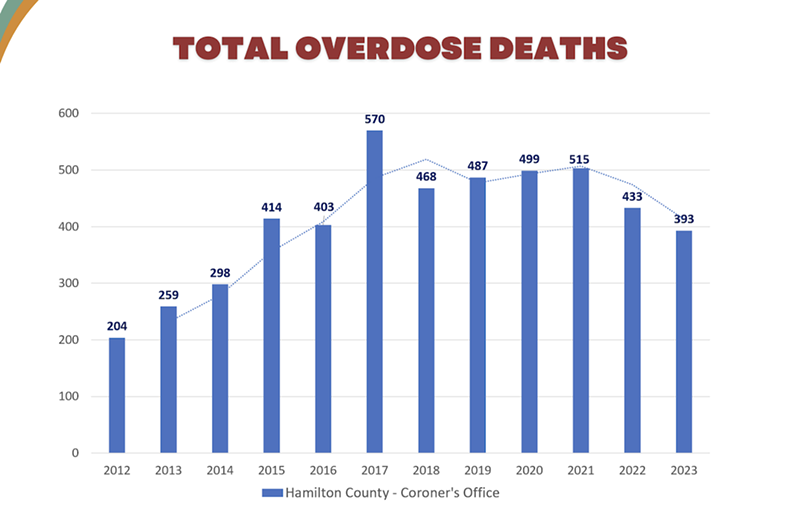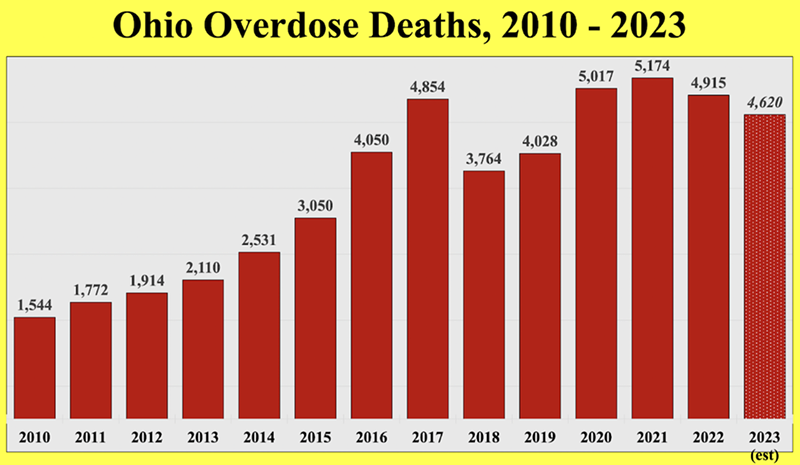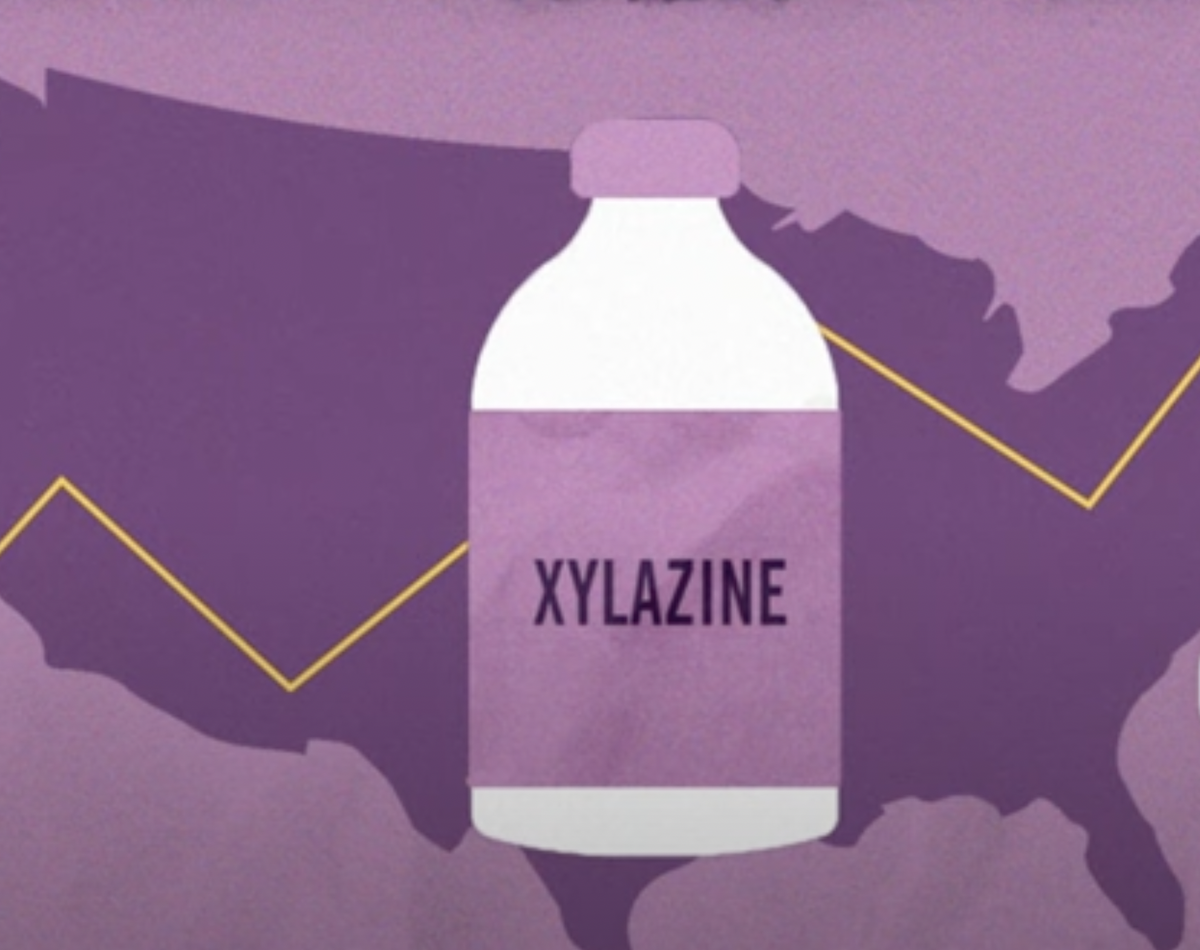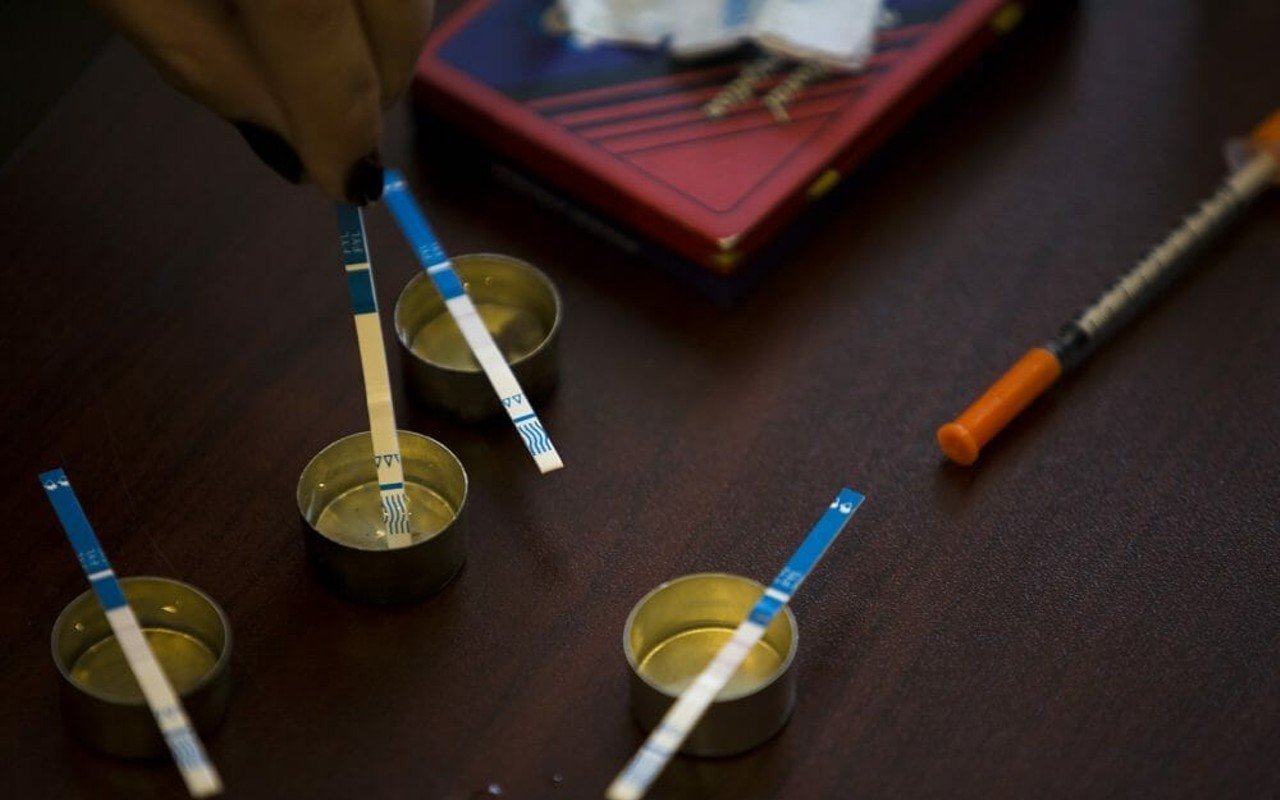The Hamilton County Addiction Response Coalition (HCARC) published its annual report last week, and while it shows a promising decline in overdose deaths, harm reduction specialists tell CityBeat that xylazine has created new problems for those suffering from substance abuse disorders.
The State of the Addiction Crisis report showed there were 393 overdose deaths in Hamilton County in 2023, down 9% from 2022. It’s been almost 10 years since overdose deaths were this low; the county logged 298 fatal overdoses in 2014. Overdoses in 2023 were down 31% compared to the crisis’ peak in 2017 when a record 570 people died of an overdose in Hamilton County.

Photo: Hamilton County Addiction Response Coalition 2023 report screenshot
It’s been 10 years since overdose deaths have been this low in Hamilton County.
The downward trend for overdose deaths is similar across the state. Harm Reduction Ohio, a nonprofit that tracks and aggregates Ohio drug overdose data, reported around 4,915 Ohioans died of an overdose in 2022. By 2023, that number (which is currently considered an estimate as year-end data continues to be reported) dropped by about 6% to 4,620. But overdoses were lower across the state as recently as 2019 when 4,028 people died of an overdose.

Photo: Harm Reduction Ohio
Around 4,915 Ohioans died of an overdose in 2022. By 2023, that number dropped by about 6% to 4,620.
HCARC executive chairwoman and Hamilton County commissioner Denise Driehaus said the year-over-year decrease in overdose deaths is a result of collaboration.
“Our approach is anchored in four fundamental pillars: prevention, treatment, interdiction, and harm reduction,” Driehaus says in the report. “Each of these pillars is fortified by the expertise of individuals serving on the subcommittees of the HCARC. Furthermore, we have cultivated strong partnerships with local governments, schools, businesses, hospitals, the faith community, and the recovery community, bolstering our efforts and amplifying our impact.”
How xylazine is changing the game
Noam Barnard is an organizer for the Coalition for Community Safety (CCS). CityBeat interviewed Barnard in April 2022 about harm reduction training for Cincinnati bartenders. At the time, fentanyl creeping into party drugs like cocaine and pressed pills was a growing problem in Cincinnati, and it still is, but Barnard said xylazine has added an entirely new layer to combating the impacts of drugs.
“I don't think we're seeing it so much with party drugs being cut with xylazine, but it's still a risk,” Barnard said. “And hopefully, not just CCS, but other organizations around town and around the country are kind of getting the message across like, ‘Hey, if you're trying to go out and party on a Saturday night, get some test strips.’ Where it gets tricky is when we go back out onto the street.”
Xylazine (also known as “tranq”) is a non-opioid veterinary tranquilizer meant for sedating animals. It’s a central nervous system depressant that can cause drowsiness, amnesia and slowed breathing, heart rate and blood pressure. Exact data on the level of xylazine found in Ohio's illicit drug supply is not yet available, but coroners across the country are starting to see more people killed by the drug, prompting the Biden administration to designate fentanyl adulterated or associated with xylazine as an emerging threat to the United States in April 2023.
Unlike fentanyl, which Barnard said has replaced the demand for heroin, xylazine is not being sought out by those who use it most, but it’s no mystery it’s what they’re getting either.
“[The people] I deal with on a regular basis that I see on the streets, sex workers, folks like that, they know it's not a risk – it's a high probability that the xylazine is gonna be in there.”
A xylazine overdose cannot be reversed with the use of Narcan because the drug is not an opioid, which means rescue breathing is the only option for someone to avoid serious injury or death.
“What that boils down to, unfortunately, is it makes the whole scenario a little bit more uncomfortable, because now you have to do rescue breathing,” Barnard said. “Now it's not just squirting a thing in somebody's nose, now you're getting real, real personal.”
The need for wound care
But what makes xylazine so different from fentanyl is its prolonged impacts on those using the drug daily. Scaly wounds can begin to pop up on all parts of the body, known as eschar, with severe enough cases resulting in limb amputation.
“Best way I could describe it is looking like a cigarette burn or a cigar burn,” Barnard said. “It starts out as a small, little sore and turns into a big mess. Without being able to have access to running water and soap and stuff like that, they fester, get worse and worse.”
Barnard and other volunteers with CCS have added first aid duties like wound dressing to their operation in response to the xylazine outbreak.
“Not only are our clients susceptible to a dangerous overdose that can't just simply be reversed by Narcan, but also we're having to offer first aid, gauze pads, medical tape, all kinds of stuff like that,” he said. “It makes our budget go up.”
In response to the increasing severity of xylazine wounds, Hamilton County Public Health has partnered with Neighborhood Health to provide mobile and in-person wound care services at the Corryville SAFE Services site in the back parking lot of 250 William Howard Taft Road.
Other mobile units like CCS and PATH Behavioral Healthcare are able to reach people in surrounding neighborhoods. Barnard said educating people about wound care is important, but meeting them where they are is critical to their health.
“That's something that we've been trying to educate people in the streets about,” he said. “It's hard to tell somebody that may be just waking up at the beginning of the day and they're feeling sick from their withdrawal symptoms, to say, ‘Hey, make sure you test your fentanyl, and also, if it has xylazine, don't use it. Give it back to your dealer.’ It just doesn't go that way.”
CCS will be conducting a free public Narcan training at Binski's Bar in Camp Washington on Tuesday, March 26 from 6-7 p.m. Barnard said questions are encouraged, including any related to saving xylazine overdoses and volunteer opportunities.








